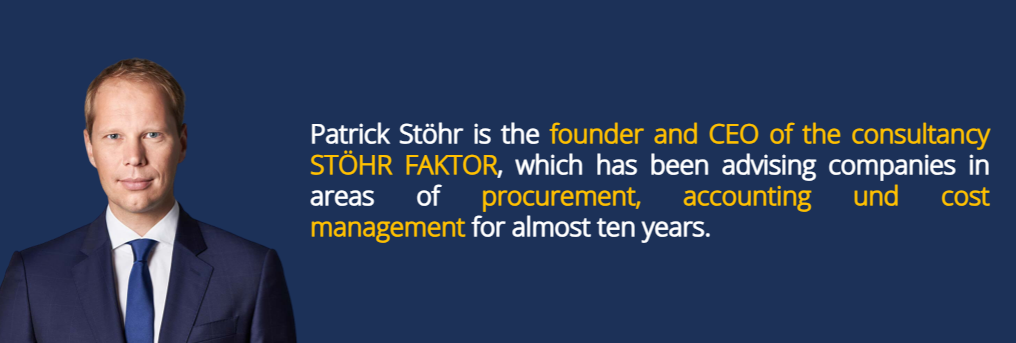Existing customer? Login
Interview
June 15th, 2023
Interview with Patrick Stöhr, founder and CEO of STÖHR FAKTOR
 Eros Vecchio
Eros Vecchio
Mr. Stöhr, today we are focusing on the topic of procurement portfolio analysis. First of all, let me ask you: What does this term actually mean?
The procurement portfolio analysis, or procurement goods/sourcing portfolio as it was originally called, is still a standard tool in procurement and serves to address strategic questions. It combines the question "Where do I procure my goods?" on the one hand with the question "Who do I actually work with?" on the other. In other words, the procurement portfolio analysis is the instrument that brings together category management and supplier management, which are two important strategic areas of focus in procurement.

Contact information:
Patrick Stöhr | CEO of the management consultancy STÖHR FAKTOR
STÖHR FAKTOR Management Consulting GmbH
Düsselstraße 4a | D-40699 Erkrath | Germany
patrick.stoehr@stoehr-faktor.de
LinkedIn Profile of Patrick Stöhr
More information about STÖHR FAKTOR
You recently launched a product for procurement portfolio analysis together with SCALUE. How did this cooperation come about?
We approached the topic together with SCALUE because SCALUE already possess a significant amount of information that is required for forming the portfolio in a native manner. By combining their expertise with our application of procurement portfolio analysis, we were able to develop a very lean and elegant solution for our clients that delivers quick and reliable results. SCALUE's IT solution also makes it straightforward to repeat the analysis as needed, allowing us the observation of portfolio changes over a certain period of time.
How does a procurement portfolio analysis work in most companies so far, if no digital solutions like SCALUE are used?
In most companies today, the procurement portfolio analysis is still implemented traditionally via workshops. However, it must be said that workshops are still an integral part of our solution. This is because in addition to spending figures, which can be easily retrieved via SCALUE, information such as supplier ratings is also required, which is not yet available at the push of a button in many companies. Instead, such information must first be recorded manually, and the tool of choice here is still Excel in the vast majority of cases.
Depending on the maturity level of the company, the question also arises as to whether there is already a product group structure on which to base the portfolio analysis, or whether this structure first needs to be formed or sharpened. Here again, SCALUE's solution proves to be an ideal partner as the Data Health component can easily identify these gaps in the product group structure.
Let's assume that I, as procurement manager, had successfully carried out my procurement portfolio analysis. What actions could be derived from this?
Before you start deriving concrete actions, you first need to take a look at the results of your analysis. Let's use a fictitious example to illustrate this: As part of your portfolio analysis, you have discovered that 80% of the spend on a particular product group is distributed across eight different suppliers. From this insight, you then deduce that you want to bundle more or switch to a dual source strategy in the future. Thanks to your portfolio analysis, you also know which two suppliers you have had particularly good experiences with to date and whether these two suppliers adhere to the agreed rules and service levels. So, in short, supplier bundling is one of the actions that could be derived from the procurement portfolio analysis.
Can your and SCALUE's solution also assist in the implementation of such actions?
Definitely. With the SCALUE Action Hub, I can easily make my actions, such as changing my supplier portfolio, trackable. This means I can simultaneously ensure the quality of the basis for my procurement portfolio analysis and monitor the progress of the identified actions. A classic win-win situation.
Since January 1, 2023, Germany has implemented the Supply Chain Due Diligence Act, which presents new challenges for many companies. Wouldn't now be exactly the right time to conduct a procurement portfolio analysis?
The Supply Chain Due Diligence Act, as it is called in Germany, went into effect this year for companies that have more than 3000 employees. For companies that have more than 1000 employees within their corporate structure, the law will apply from next year. In total, this means that around 2900 companies will have to actively deal with the issue this year - just to put things in perspective.
An important part of the upply Chain Due Diligence Act will, of course, be risk analysis, which is one of the essential aspects to deal with in the procurement portfolio analysis. However, this does not mean that the procurement portfolio analysis fully covers the entire requirements of the upply Chain Due Diligence Act and the associated due diligence obligations; it is certainly an important building block, as previously mentioned.
How would you proceed if one of these 2900 companies wanted to conduct a procurement portfolio analysis with you and SCALUE?
Ideally, we would start by importing all available procurement data into the SCALUE tool. This would provide the company with a transparent overview of the largest cost blocks and the areas with the greatest potential for improvement. At the same time, e would work together with the company to identify risks along the supply chain.This has been particularly important during the COVID-19 pandemic, and it remains crucial in the current economic environment with supply chain disruptions and other challenges - you need to know exactly where problems occur or where supply relationships need to be actively managed.
In addition to the financial aspect, this provides a second criterion for deciding which product group or which set of suppliers to ganalyze in-depth based on both financial considerations and risk factors. It is important to note that most companies simply do not have the capacity to analyze all product groups equally in the context of portfolio analysis. And that's perfectly fine, by the way.
How likely do you think it is that procurement departments will use a digital solution like SCALUE for their portfolio analysis? Digitalization is still lagging behind in Germany, after all...?
At this point, I have to say something in advance that we also tell our customers again and again:
Digitalization is not a classic checkbox that you simply check off, but digitalization should be understood much more as a process. Accordingly, the degree of maturity of companies in Germany in terms of digitalization also varies greatly.
Because of this, we at STÖHR FAKTOR have incidentally developed the so-called Digital Readiness Check, which quite simply shows where a company stands in the area of digitalization and where there is still a need for action. At this point, it is perhaps quite exciting to note that one of the biggest obstacles in the area of digitalization, which we discover time and again in the course of our check, is the failure to bring one's people along. After all, digitalization always means change, and that is something you first have to win people over to.
Wouldn't a digital procurement portfolio analysis in collaboration with STÖHR FAKTOR and SCALUE be a good way to start the digitalization process?
For my part, I believe that the SCALUE Strategy Hub is interesting for companies of all maturity levels and can generate added value regardless of the digital maturity of the procurement department. For the more mature companies, which already have significantly more procurement data available, it may primarily mean added value in financial terms. And for the, let's say, more immature companies, the Strategy Hub provides full visibility into cost and delivery type structures for the first time. Accordingly, in all cases, Strategy Hub is a valuable digital toolkit that enables procurement to quickly and easily strengthen its position in the company.
Now we have already covered two major topics in procurement with the Supply Chain Act and digitalization. What other trend do you think will play a major role in 2023?
I think the whole topic of ESG or sustainability will be of great importance this year. It would probably be an even bigger issue if supply chains weren't as disrupted as they currently are.Nevertheless, many companies, partly due to the supply chain law, will have to focus on their own sustainability goals. Procurement plays a central role in this regard, so ESG is definitely one of the major themes for 2023.
You want to learn more about how SCALUE's solution can help you optimize your purchasing?
Wouldn't ESG also be a topic that could be well covered as part of a procurement portfolio analysis?
Absolutely. That's why we're working with SCALUE and the scientific community to find out which evaluation criteria could play an important role for suppliers in the future. And the aspect of sustainability will of course be much more important than it was in the past. Accordingly, we are also interested in including current requirements for suppliers, product groups, and management in the portfolio analysis and mapping them accordingly in the Strategy Hub.
Would you like to conclude this interview by once again promoting your joint solution for digital procurement portfolio analysis?
Certainly. So I think that with the Strategy Hub, we offer companies a technological solution with which they can use a set of tools that have been tried and tested over decades to safeguard their supply chain and at the same time reduce costs in procurement. The exciting aspect of combining it with the SCALUE solution is that the results from the portfolio analysis are documented and presented with a direct reference, making them easily traceable. In this way, both companies with high data quality and digitally less mature companies can easily understand how individual measures have contributed to the subsequent development of results.

How SCALUE can help you? Schedule a free demo now!
Learn more on our blog: Get More Insights
Follow us on LinkedIn: Get more Content